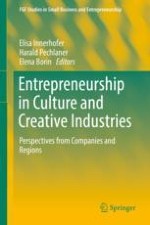2018 | OriginalPaper | Chapter
Culture-Based Products: Integrating Cultural and Commercial Strategies
Authors : Chiara Isadora Artico, Michele Tamma
Published in: Entrepreneurship in Culture and Creative Industries
Publisher: Springer International Publishing
Activate our intelligent search to find suitable subject content or patents.
Select sections of text to find matching patents with Artificial Intelligence. powered by
Select sections of text to find additional relevant content using AI-assisted search. powered by
